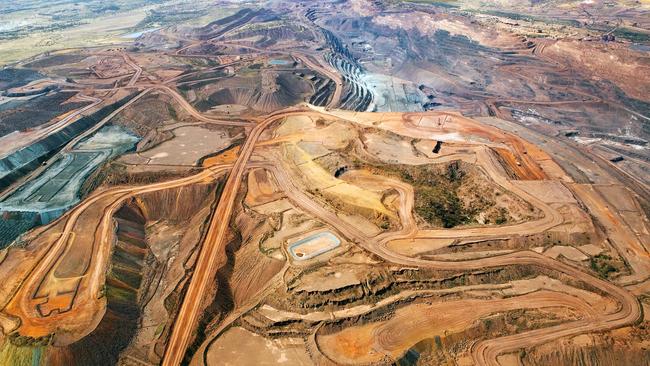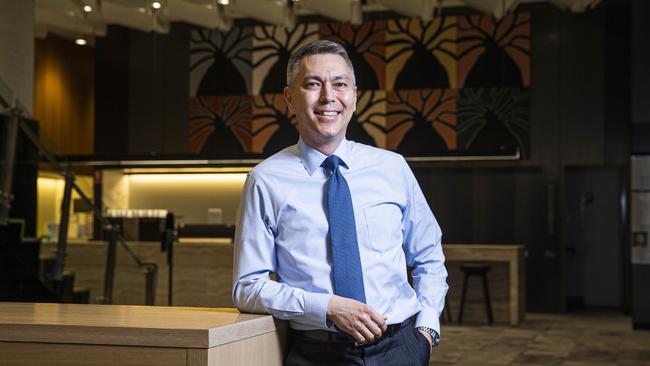BHP extends iron ore’s run of record dividends as its sheds petroleum business
BHP boss Mike Henry has stamped his own mark on the world’s biggest mining company, launching a radical reshaping of BHP’s structure and mix.

BHP boss Mike Henry has stamped his own mark on the world’s biggest mining company, launching a radical reshaping of BHP’s structure and mix with the company to exit petroleum, enter the potash market and unifying the company’s corporate structure in Australia.
BHP will pay a record $US2 a share dividend on the back of an $US11.3bn ($15.5bn) net profit for the full year, taking its total return to shareholders to $US15bn for the full year, according to Mr Henry.
The company announced it has approved the $US5.7bn construction of the first stage of its Jansen potash project in Canada, accelerating its transition to Mr Henry’s favoured “future facing commodities” while also confirming the divestment of its petroleum business to Woodside.
And Mr Henry also announced the biggest shift in BHP’s structure in a generation, saying the company would abandon the dual-listed structure it adopted after its merger with Billiton in 2001, and focus on its Australian listing.
BHP released its full year accounts late on Tuesday, saying it had booked underlying earnings of $US17.07bn for the full year on revenue of $US60.8bn.
The mining giant will pay a record $US10bn final dividend for the full year, having already paid about $US5bn after its half year announcement in February.
Mr Henry told reporters that, despite the challenges posed by the global coronavirus crisis, BHP had delivered a strong set of financial results.
“We generated record free cash flow, return on capital employed strengthened to 32 per cent and our balance sheet is strong,” he said.
“We ended the year with net debt of $US4bn and the board approved a record final dividend of $US2 per share, delivering total returns to shareholders of $15 billion for the full year – this is a payout ratio of 80 per cent.”

BHP chairman Ken MacKenzie said in a statement that BHP’s record performance over the last year had sent the company up to transition its business for the future.
“BHP is in a strong position to manage its future in a time of rapid change. Jansen Stage 1 will give BHP exposure to a commodity with a strong demand outlook and decades of potential growth,” he said.
“The agreement to pursue a merger of BHP’s petroleum business with Woodside will maximise the value of our oil and gas assets through increased operating scale and synergies, with a more diversified product portfolio to support the energy transition. Now is the right time to unify BHP’s corporate structure. BHP will be simpler and more efficient, with greater flexibility to shape our portfolio for the future.”
Consensus analyst estimates had expected a total dividend of about $US2.89 a share for the year, below the $US3.01 BHP delivered, on net profits – before any exceptional items – of $US17.46bn, and underlying earnings of $US30.29bn.
The annual profit comes after BHP’s flagship Pilbara iron ore division hit new production records as the price surged in the first half of the year, with the company exporting 139.7 million tonnes in the first half of 2021 as prices hit their highest levels since the boom.
The company’s Pilbara mines shipped 283.9 million tonnes for the full financial year, marginally above the 283.3 million tonnes from the previous year, after exporting 73.7 million tonnes for the June quarter.
BHP’s iron ore division again dominated its earnings results, with underlying earnings before interest and tax of $US24.29bn, or about 80 per cent of its total underlying earnings of $US30.29bn.
BHP’s chief Pilbara rival, Rio Tinto, paid out $12.4bn in half-year dividends as the iron ore price boosted its profits into record territory and the mining giant found itself in a net cash position for the first time in more than a decade.
The BHP dividend extends the stellar returns for investors in iron ore companies over the last 18 months, after Rio Tinto upped its interim dividend to record levels on the back of its Pilbara profit flow.
Rio delivered its half year financial results in late July, saying it would return 75 per cent of its underlying half year earnings to shareholders through a $US6.1bn ordinary dividend and a $US3bn special dividend.
Rio booked an after-tax profit of $US12.3bn for the first half, on free cash flow of $US10.2bn from its global operations.
Fortescue Metals Group will deliver its own annual financial results next week, with the market also expecting a bumper divided announcement when it does.
But that could be the last of the massive iron ore dividend cheques for a while, with the price of the commodity on the slide as China looks to curtail steel production in the second half of the year.
While still well above historic average prices, the price of iron ore has slumped from more than $US220 a tonne a month ago to $US161.20 on Monday, with new figures showing China’s daily crude steel output fell sharply in July, to the lowest levels since March 2020 – when the coronavirus was in full swing.
CBA analysts noted on Tuesday that China’s crude steel output still needs to fall another 12 per cent from August until the end of the year to meet the Chinese government’s desired outcome of maintaining 2021 production levels at about those achieved in 2020.
“We think policymakers will eventually relax steel output restrictions when steel prices increase because the steel output cuts are more severe than any slowdown in China’s steel demand,” CBA analyst Vivek Dhar told clients on Tuesday.
BHP’s net profit included $US5.8bn in impairments and one-off charges, including tax impacts.
The company declared a $US2.07bn impairment of Jansen, $US2.18bn in impairments against its energy coal assets – including writing down its Mt Arthur thermal coal mine in NSW to a negative value, to reflect the rehabilitation costs of the mine – and a $US1.16bn charge related to its half-ownership of the Samarco iron ore operations in Brazil.
BHP also flagged $US400m worth of costs related to the global coronavirus pandemic.





